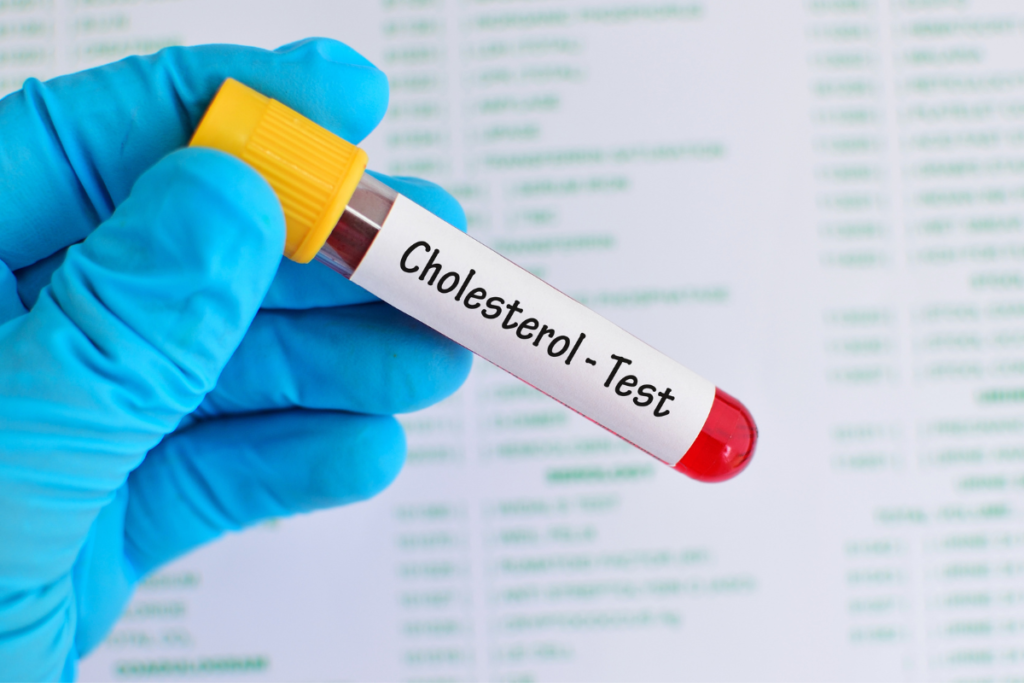Statins

Statins (HMG-CoA reductase inhibitors) are drugs in therapy cardiovascular-related conditions. They have for lipid-lowering and cardioprotective effects. The first statin was discovered by a Japanese biochemist Akira Endo in 1971, who was researching microorganisms and their production of certain enzyme inhibitors, which they form as a defense mechanism from other microorganisms. Those products were blocking the synthesis of mevalonate, a precursor of ergosterol, which is an important part of the microorganism’s cell wall. First substance with HMG-CoA reductase inhibiting effect was mevastatin. In 1978 Merck Research Laboratories discovered lovastatin, the first commercially available statin. Since then, scientists invented plentiful of statins, as their discovery represents a great breakthrough in lipid-lowering treatment. Despite the high price, many doctors prescribe them every year.
Cholesterol

Cholesterol is an essential element in the human organism with many functions. It’s a structural part of all body’s cells, where cholesterol plays a significant structural role in cell membranes. Cholesterol is also a precursor for the synthesis of steroid hormones, bile acids, and vitamin D. Approximately 1/3 of total cholesterol is ingested with food, but other 2/3 is formed in the liver. The biosynthesis of cholesterol is a complex biochemical process, including numerous steps.
The first major step is the conversion of Acetyl CoA into HMG-CoA (3-hydroxy-3-methylglutaryl-CoA). In the second stage, HMG-CoA is reduced to mevalonate by the enzyme HMG-CoA reductase. Mevalonate is then converted to isopentyl pyrophosphate (IPP) in the third stage, while in the fourth stage IPP molecules convert to squalene. The fifth and final stage includes the cyclization of squalene into lanosterol and its series of 19 additional reactions where it converts into cholesterol.
Although cholesterol plays an important role in the human organism, it is also related to the process of atherosclerosis. When the low-density lipoprotein (LDL) cholesterol, as known as “bad” cholesterol is in high concentration, it accumulates in arterial walls and becomes oxidized, inducing inflammation. Then it converts into big foam cells. These foam cells promote proliferation and migration of vascular smooth muscle cells, as well as collagen production, in the end making the atherosclerotic plaque, with lipids on the middle, and a fibrous cap on the outside. Over time atherosclerosis may invoke a heart attack, stroke or ischemic heart disease.
Mechanism of action of Statins
Statins are competitively inhibiting the enzyme HMG-CoA reductase, thus interfering with the conversion of HMG-CoA to mevalonate, and blocking the organism’s biosynthesis of cholesterol.
This effect is present due to the similarity between statin’s and HMG-CoA’s molecule, which enables them to bind to the enzyme’s active site and block it. Cholesterol synthesis occurs mostly at night, so statins should be one time per day, usually in the evening. As the cholesterol levels in the blood are decreased, the liver produces more LDL receptors on its surface, which causes the increased removal of LDL from blood, additionally lowering cholesterol concentration. Statins lower the LDL levels for about 40% (20 – 55% depending on a patient), displaying their effects gradually after roughly 2 – 3 weeks to 2 – 3 months.
Types
Statins are divided into two classes including fermentation-derived (natural) statins and synthetic statins. They are usually metabolized in the liver, which is also a place where they take action, but besides that, it could be a place for interactions with other drugs.
Fermentation-derived statins
As the first discovered HMG-CoA reductase inhibiting agent was produced by a microorganism, scientists were searching for more similar substances (mostly from the mold). Statins of this type are lovastatin (found in oyster mushrooms and red yeast rice), simvastatin (one of the most used statins besides atorvastatin; it is made from fungus Aspergillus terreus), and pravastatin (it is a derivatized version of the first discovered statin, mevastatin, who was isolated from Penicillium citinium; pravastatin is a metabolite isolated from cultures of Nocardia autotrophica).
Synthetic statins
Synthetic statins are synthesized in the laboratories by controlled chemical reactions. This group includes atorvastatin, rosuvastatin, cerivastatin, rosuvastatin, and pitavastatin.
Indications of Statins
Statins are very effective lipid-lowering medications. Doctors use in hyperlipidemia and in primary and secondary prevention of cardiovascular diseases such as heart attack and stroke.
Hypercholesterolemia
High levels of cholesterol in blood resemble hypercholesterolemia. It can be hereditary or acquired due to obesity, diet, diabetes type 2 or hypothyroidism. It is asymptomatic in itself, but over time it may lead to atherosclerosis and cause dangerous cardiovascular effects. Statins are used in the treatment of hypercholesterolemia if diet change or other non-pharmaceutical measures (physical exercise, weight loss) don’t show effect.
Primary prevention
Primary prevention is the prevention which is used before the occurrence of the disease. Since high cholesterol levels are increasing the risk for heart-related diseases the American College of Cardiology and the American Heart Association recommend treatment with statins in primary prevention for cardiovascular diseases of people with high LDL cholesterol ≥190 mg/dL (≥4,9 mmol/L); patients 40 – 75 years old with diabetes and LDL cholesterol of 70 – 189 mg/dL (1.8 – 4.9 mmol/L); and patients 40 – 75 year old with no diabetes and LDL cholesterol of 70 – 189 mg/dL (1.8 – 4.9 mmol/L) with estimated 10 year Atherosclerotic Cardiovascular disease (ASCVD) risk > 7.5% by their guidelines.
Statins are decreasing the levels of C-reactive protein and other inflammatory mediators, which are involved in atherosclerotic plaque building. They are altering the composition of plaque, interfering with collagen, thus stabilizing the cap. Statins induce the apoptosis (programmed cell death) of the vascular smooth muscle, decreasing the blood vessel enlargement. They are repairing the endothelial permeability and function, acting like antioxidant agents and lowering the transformation of LDL particles into foam cells.
Secondary prevention
Secondary prevention resembles a reduction of the disease’s impact that has already occurred. By the American College of Cardiology and the American Heart Association guidelines, patients with diagnosed ASCVD benefit from statin therapy, as statins are decreasing the death rate, reducing the rate of recurrent coronary heart disease and the need of coronary revascularization in patients with heart diseases.
Contraindications
As in all other drug types, there are some conditions, where statins should be avoided including an active hepatic disease or unexplained persistent elevated aminotransferase levels. Patients should not use statins during pregnancy and breastfeeding.
Pregnancy and breastfeeding
Pregnant women should not use them. The reason is cholesterol is a crucial part of fetus development, and a lack of cholesterol can induce some congenital malformations. Pregnant and women who are breastfeeding need to lose their cholesterol levels in another way.
Active liver disease
Liver disease or hepatic disease is a type of disorder that damages the liver. Doctors don’t use them in ongoing liver disease as they can express hepatotoxic effect, additionally damaging the injured liver, worsening its original state, sometimes leading to liver failure. As statins are metabolized via the liver, they are not eliminated adequately with a diseased liver, so they accumulate in the organism, causing various damaging effects. They can increase the elevations in liver enzymes.
Unexpected persistent elevations of aminotransferase levels
If the liver enzymes are elevated persistently, and over 3 times the normal level, they can lead to liver damage. Because statins may cause these elevations, although they are mild and reversible, they should not be used in this state, as they can worsen it. Changes in the liver may go by unnoticed, so it is recommended to monitor liver enzymes levels in statin therapy.
Side effects
Statins are generally safe medications, but like all other drugs they can show up some side effects in some patients, especially if they are used in high concentrations in people older than 75 years.
Myopathy – Myopathy is a common side effect of statins. It is dose-related, meaning that it can occur if high doses of statins are used. It includes muscle pain, or muscle weakness, which can’t be explained in any other way. This muscle discomfort can be mild, or serious enough to interfere with a patient’s daily routine. Very rarely, myopathy can progress into rhabdomyolysis, which represents severe muscle pain, vomiting, and confusion. It may cause kidney failure and death. An indicator for muscle damage is the enzyme creatine kinase (CK), and doctors should check levels if muscle pain or weakness occurs.
If CK levels are elevated 5 times than normal, statin therapy should be stopped. Creatine kinase levels checking is not a regular test, it is needed only in severe muscle pain or, muscle weakness. Increase in CK levels is often induced by undiagnosed hypothyroidism, so thyroid hormones should also be checked. Other conditions that increase the risk for myopathy during the statin use are renal failure, old age, and the use of certain medications.
Hepatotoxicity
Hepatotoxicity (liver damage) – Sometimes, the enzymes that indicate the liver inflammation known as transaminases are higher than normal. This can be seen in statin therapy, but it is transient, and it usually resolves during the therapy or shortly after suspension of the therapy. Elevated transaminase levels are more common than elevated creatine kinase levels but are also a rare occurrence. Check up the transaminase levels at the beginning of statin therapy, while regular check-ups aren’t necessary. If the levels of these enzymes are than 3 times more than normal, statins should be excluded from patient’s treatment. If the signs of hepatotoxicity including unusual fatigue or weakness, loss of appetite, abdominal pain in the upper right side of the abdomen, dark-colored urine, yellow coloring of the skin and eyes (jaundice), nausea and vomiting occur, liver enzyme doctors should check it.
Type 2 diabetes – During a statin therapy, glucose levels may increase, leading to type 2 diabetes. This is a rare effect but can affect people with already elevated blood sugar. Statins decrease the uptake of glucose to cells as a response to insulin. The advantage of statin use prevails this risk, as the people with diabetes who take statins have lowered chance for heart attack occurrence.
Other non-specific side effects which may occur are fatigue, headache, digestive system problems (upset stomach, dyspepsia, constipation, diarrhea), and nosebleeds.
Interactions of statins
Statins can interact with many various drugs, so be sure to tell your doctor or your pharmacist which drugs you are using.
Fibrates
Fibrates lowers triglycerides. If doctors use them at the same time as statins, a chance for rhabdomyolysis increases. That is due to inhibition of statin glucuronidation (drug metabolism process), especially with gemfibrozil.
Coumarins (Warfarin)
Statins may increase the anticoagulation effect of coumarins, leading to hemorrhagic events. People who use warfarin should check INR (International Normalised Ratio which determines the blood clotting tendency) before starting of statin therapy.
Strong inhibitors of CYP3A4
Cytochrome P450 3A4 (CYP3A4) is an enzyme, mainly found in the liver. It is responsible for the oxidation of some drugs, including statins and enabling their elimination. Several drug groups may inhibit the function of this enzyme, preventing the elimination process of statins in the organism. Grapefruit juice can also inhibit this enzyme. Drug classes that strongly inhibit CYP3A4 are some azole antifungal drugs, some macrolide antibiotics, and HIV protease inhibitors.
Moderate inhibitors of CYP3A4
Drugs like calcium channel blockers verapamil and diltiazem, antiarrhythmic agent amiodarone, and immunosuppressant medication cyclosporine are moderate inhibitors of CYP3A4. They can increase the concentration of statins in blood, potentially inducing their side effects.
Nicotinic acid
Nicotinic is in the therapy of dyslipidemia. Caution is needed if it’s combined with statins, as it can increase the risk of muscle damage and hepatotoxicity.
Ezetimibe
Ezetimibe is the drug that decreases cholesterol absorption in the small intestine. It increases risk of myopathy when it is in combination with statins.
